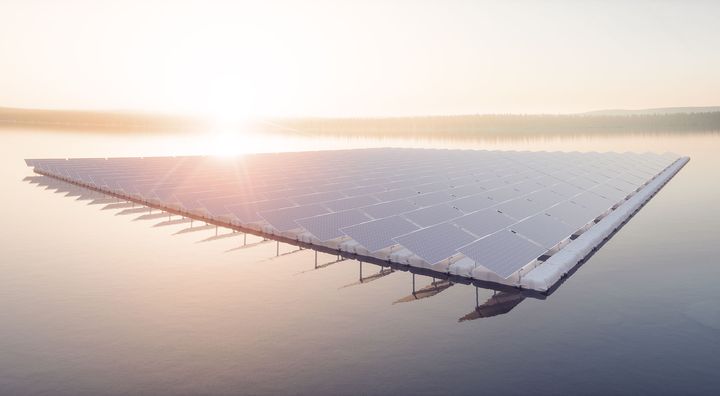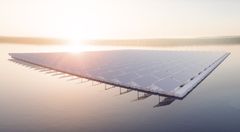Innovative partnership ensures world’s first automatic wave model

The results from the collaboration makes Glint Solar the only company in the world to offer an automatic process when finding and analysing different locations to install floating solar energy. Adding NGI's algorithms, the transition from a manual to an automatic process will drastically reduce both time and costs when finding and analysing these locations.
- The floating solar sector is looking for better insight to reduce project risks. We are therefore pleased to have initiated a strong collaboration with NGI on this unique wave model and look forward to continuing the great collaboration as we're accelerating the adoption of solar energy, says Harald Olderheim, CEO at Glint Solar AS.
Quality and insight give the best results
While generally safe, there have been some accidents at floating solar installations caused by extreme weather. As land-based solar developers are increasingly looking to lakes and reservoirs to build out floating solar, there is a need to understand the site’s environmental characteristics with waves being one essential parameter. The clue is to find the best suited places to install this technology.
With funding from the Oslo Regional Research Fund (RRF), Glint Solar and NGI began working on a qualification project to see if it was possible to find scalable solutions or methods for automatic calculation of wave heights and wind directions for floating solar. Input to the methodology is the geometry of the lake as well as 40 years of data on wind conditions.
- The collaboration with Glint Solar comes as a direct result of the strategic investment in capacity on storm surges and wind waves in recent years. We are pleased that NGI has been chosen to contribute with our expertise into a future-oriented industry such as floating solar energy and are looking forward to further collaboration, says Sylfest Glimsdal, Senior specialist at NGI.
The algorithms developed in the project will be used when analysing where it is best to install floating solar technology. Despite the wave model being very new, Glint Solar has already used the new technology with several customers around the world, including a project Glint Solar did for the World Bank in South East Asia.
Why floating solar?
To mitigate climate change, the world needs to accelerate the adoption of renewable energy. In many countries available land for solar energy projects are scarce due to agriculture, protected nature or high population. Utilizing available artificial lakes and reservoirs allows for the installation of solar without land conflict. The water may in many cases also provide additional cooling for the solar panels, increasing the energy yield with several percentage points compared to land-based solar.
Lastly, in certain regions floating solar installations may also reduce a lake’s water evaporation and algae growth, further adding to the overall benefits in what is one of the fastest growing energy segments in the world.
To view this piece of content from www.youtube.com, please give your consent at the top of this page.
Keywords
Contacts
Carl Bonnevie HarbitzHead of sectionRiSC
Tel:922 39 636carl.bonnevie.harbitz@ngi.noSylfest GlimsdalSenior SpecialistRiSC
Tel:909 72 669sylfest.glimsdal@ngi.noImages
About NGI
På sikker grunn
NGI – Norges Geotekniske Institutt – er et uavhengig, internasjonalt senter for forskning og rådgivning innen ingeniørrelaterte geofag, der vi integrerer kunnskap mellom geoteknikk, geologi og geofysikk. Vår forskning gir kunnskap som styrker norsk næringsliv til å løse noen av de viktigste utfordringene vi står overfor innenfor klima, miljø, energi og naturfarer.
Gjennom årene har vi tiltrukket oss dedikerte fagfolk og internasjonale eksperter på bruk av geomaterialer som byggegrunn og byggemateriale, skredproblematikk og forurensning av grunnen. Utvikling og anvendelse av ny teknologi står helt sentralt i vår virksomhet for å finne bærekraftige løsninger og sikre at vi bygger et samfunn på sikker grunn. Vår ekspertise og løsninger er kjent og etterspurt i store deler av verden.
NGI har hovedkontor og laboratorier i Oslo, avdelingskontor i Trondheim, forskningsstasjon for snøskred på Strynefjellet, og utenlandskontorer med geoteknisk laboratorium i Houston, Texas, USA, og i Perth, Western Australia, i tillegg til samarbeidsavtaler med veletablerte selskap og institusjoner i store deler av verden.
NGI ble formelt opprettet 1. januar 1953, underlagt Norges Teknisk-Naturvitenskapelige Forskningsråd (NTNF). I 1985 ble NGI omgjort til en selvstendig stiftelse. Driftsvirksomheten (forskning og rådgivning) ble 1. januar 2024 overført til Norges Geotekniske Institutt AS, et aksjeselskap som eies 100 % av stiftelsen NGI.
Som en av hovedpartnerne støtter NGI Ingeniører Uten Grenser (IUG) økonomisk og gjennom å bidra med ingeniørkompetanse til IUGs oppdrag for norske bistandsorganisasjoner.
Subscribe to releases from NGI
Subscribe to all the latest releases from NGI by registering your e-mail address below. You can unsubscribe at any time.
Latest releases from NGI
Global modell skal gjøre verden bedre rustet mot tsunamier17.11.2025 11:46:45 CET | Pressemelding
Da en enorm flodbølge traff kystene rundt Indiahavet andre juledag i 2004, mistet mer enn 220 000 mennesker livet. Det var en katastrofe som rystet verden og som avslørte hvor lite vi egentlig forsto om tsunamier.
NGI-forsker valgt inn i styret til European Chemicals Agency (ECHA)24.10.2025 12:15:11 CEST | Pressemelding
Forsker ved NGI - Norges Geotekniske Institutt, Hans Peter Arp, er én av verdens fremste eksperter på kjemisk forurensning. Nå skal miljøkjemikeren påvirke kjemikaliepolitikken i Europa.
NGI lanserer unikt traineeprogram innen geoteknikk30.9.2025 09:11:00 CEST | Pressemelding
Fire nyutdannede ingeniører får nå muligheten til å prøve seg på tvers av NGIs kjerneområder. Gjennom et nytt traineeprogram skal de utforske alt fra fundamentering på land til havvind og klimatilpasning.
Flere velger geoteknikk og kvinneandelen skyter i været11.9.2025 08:55:38 CEST | Pressemelding
Masterstudiet i geoteknikk ved OsloMet vokser raskt. Da studiet startet i 2022, var det fem studenter og bare menn. Denne høsten har 21 nye studenter startet, av dem åtte kvinner.
Vi kan bygge tryggere tunneler med kunstig intelligens15.8.2025 14:51:34 CEST | Pressemelding
Kunstig intelligens endrer hvordan vi bygger tunneler. Vi kan forutsi farlige forhold i berget før vi treffer dem. Det gir tryggere tunneler, lavere kostnader, mindre naturinngrep og bedre beslutninger under bakken.
In our pressroom you can read all our latest releases, find our press contacts, images, documents and other relevant information about us.
Visit our pressroom

